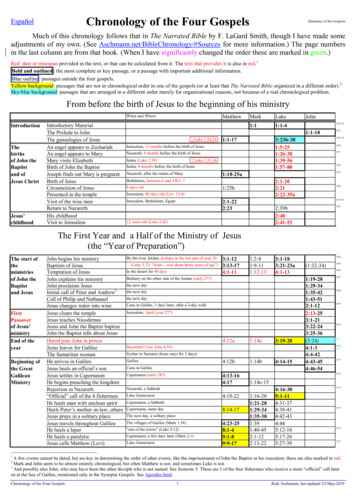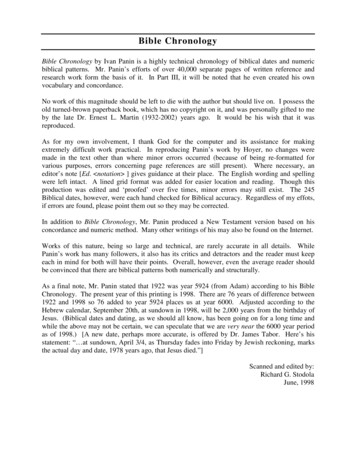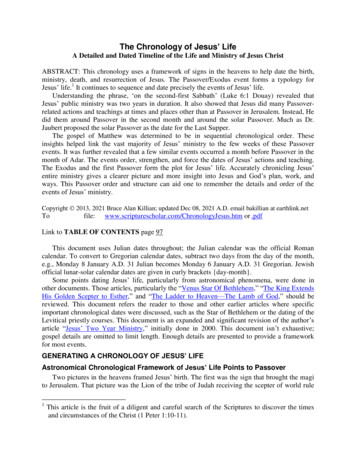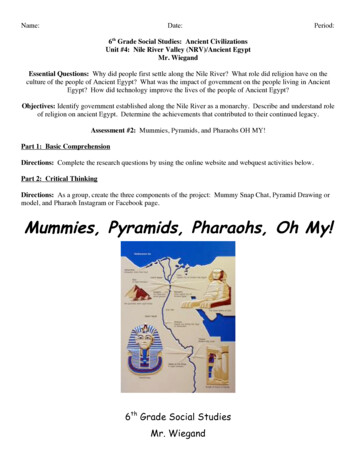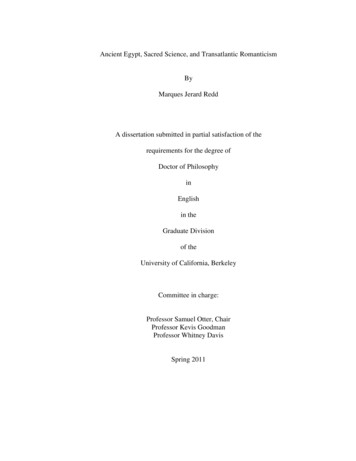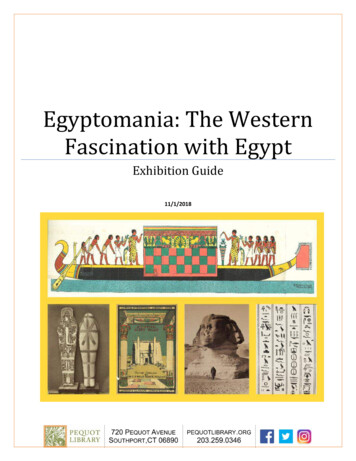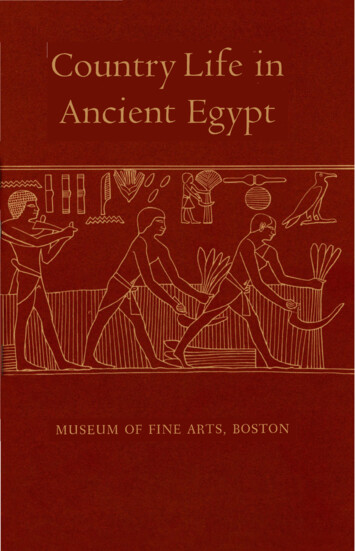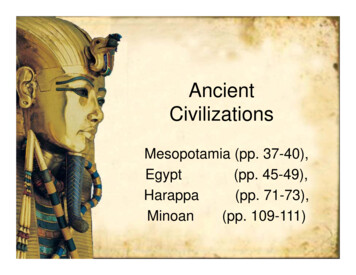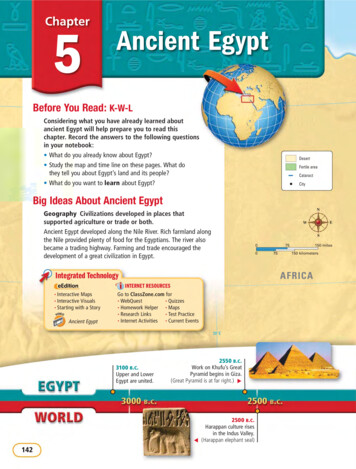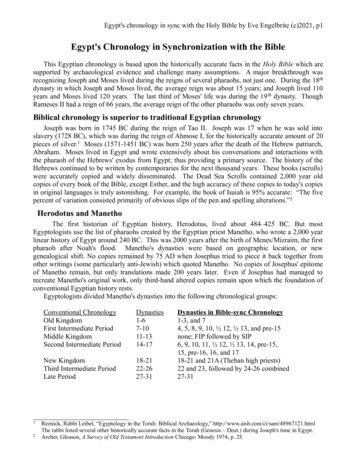
Transcription
Egypt's chronology in sync with the Holy Bible by Eve Engelbrite (c)2021, p1Egypt's Chronology in Synchronization with the BibleThis Egyptian chronology is based upon the historically accurate facts in the Holy Bible which aresupported by archaeological evidence and challenge many assumptions. A major breakthrough wasrecognizing Joseph and Moses lived during the reigns of several pharaohs, not just one. During the 18thdynasty in which Joseph and Moses lived, the average reign was about 15 years; and Joseph lived 110years and Moses lived 120 years. The last third of Moses' life was during the 19 th dynasty. ThoughRameses II had a reign of 66 years, the average reign of the other pharaohs was only seven years.Biblical chronology is superior to traditional Egyptian chronologyJoseph was born in 1745 BC during the reign of Tao II. Joseph was 17 when he was sold intoslavery (1728 BC), which was during the reign of Ahmose I, for the historically accurate amount of 20pieces of silver.1 Moses (1571-1451 BC) was born 250 years after the death of the Hebrew patriarch,Abraham. Moses lived in Egypt and wrote extensively about his conversations and interactions withthe pharaoh of the Hebrews' exodus from Egypt; thus providing a primary source. The history of theHebrews continued to be written by contemporaries for the next thousand years. These books (scrolls)were accurately copied and widely disseminated. The Dead Sea Scrolls contained 2,000 year oldcopies of every book of the Bible, except Esther, and the high accuracy of these copies to today's copiesin original languages is truly astonishing. For example, the book of Isaiah is 95% accurate: “The fivepercent of variation consisted primarily of obvious slips of the pen and spelling alterations.”2Herodotus and ManethoThe first historian of Egyptian history, Herodotus, lived about 484–425 BC. But mostEgyptologists use the list of pharaohs created by the Egyptian priest Manetho, who wrote a 2,000 yearlinear history of Egypt around 240 BC. This was 2000 years after the birth of Menes/Mizraim, the firstpharaoh after Noah's flood. Manetho's dynasties were based on geographic location, or newgenealogical shift. No copies remained by 75 AD when Josephus tried to piece it back together fromother writings (some particularly anti-Jewish) which quoted Manetho. No copies of Josephus' epitomeof Manetho remain, but only translations made 200 years later. Even if Josephus had managed torecreate Manetho's original work, only third-hand altered copies remain upon which the foundation ofconventional Egyptian history rests.Egyptologists divided Manetho's dynasties into the following chronological groups:12Conventional ChronologyOld KingdomFirst Intermediate PeriodMiddle KingdomSecond Intermediate PeriodDynasties1-67-1011-1314-17New KingdomThird Intermediate PeriodLate Period18-2122-2627-31Dynasties in Bible-sync Chronology1-3, and 74, 5, 8, 9, 10, ½ 12, ½ 13, and pre-15none; FIP followed by SIP6, 9, 10, 11, ½ 12, ½ 13, 14, pre-15,15, pre-16, 16, and 1718-21 and 21A (Theban high priests)22 and 23, followed by 24-26 combined27-31Reznick, Rabbi Leibel, “Egyptology in the Torah: Biblical Archaeology,” http://www.aish.com/ci/sam/48967121.htmlThe rabbi listed several other historically accurate facts in the Torah (Genesis – Deut.) during Joseph's time in Egypt.Archer, Gleason, A Survey of Old Testament Introduction Chicago: Moody 1974, p. 25
Egypt's chronology in sync with the Holy Bible by Eve Engelbrite (c)2021, p2Turin King List on PapyrusIn the 1800's, an Italian discovered a list of kings on the back of a tax scroll along with severalpapyrus fragments, and it was placed in the Egypt Museum in Turin, and dubbed the Turin King List(TKL). It was most likely a scribal student's homework. Regarding the tabulation of years ruled by the12th dynasty, Ryholt noted “Apparently the scribe did not realize that several of the reigns in questionincluded a period of coregency, and that the duration of the dynasty was therefore in reality muchshorter.”3 Ryholt wrote, “. . . the Turin King-list proceeds chronologically throughout, except thatcontemporary dynasties are recorded one at a time in order not to mix kings of different dynasties . . .” 4and added it is “the only genuine king-list from ancient Egypt.” 5 Turin King List is written in columnswhich are noted by Roman numerals followed by an Arabic number for the place in the column. TheTurin King List has discrepancies and many additions to those kings found in Manetho's list. The TurinKing List includes dynasties which are usually dismissed by chronologists: the pre-15 th dynasty oftwelve kings (X/1-12), the pre-16th dynasty of eight kings (X/22-30), the Thinis dynasty of five kings(XI/10-15) placed by the 13th dynasty, and the 16 kings of the Abydos dynasty (XI/16-31) placed bykings of the 14th dynasty.The TKL included years, months, and days of reigns for most pharaohs from the 1 st through 17thdynasties, but only round years for kings of the 3rd - 6th, and the 11th dynasties; which intimates the listwas a compilation of copies,6 and a clue as to changes of the location of the royal residence.Dynasties1-23-47-101112-16Reign in TKLYears, months, days; king's ageYears onlyYears, months, daysYears onlyYears, months, daysRoyal ResidenceThinisMemphis7-8 Thinis; 9-10 delta Thebes12 Itjtawy; 13-16 variousDynasties 3, 4, and 6 ruled from Memphis, with dynasty 5 being the offspring of dynasty 4 ruling inHwt-Nen-Nesu ('house of royal child').7 Dynasties 7-8 ruled in Thinis while dynasties 9-10 of theHerakleopolitan dynasty ruled in Asyut, Herakleopolis Magna, and the delta ports as the main traders.Dynasty 12 had a royal residence at Itjtawy/Lisht. Dynasty 13's TKL heading is “Kings who cameafter the King of [Upper and] Lower Egypt [Sehet]epibre . . .” 8 Thus it is very clear that the dynasty13 kings came right after (Sehetepibre) Amenemhat I, with most being his sons, and was concurrentwith dynasty 12. Dynasty 13 initially ruled from Madamud and Thebes, but retreated to outlyingnomes when dynasty 11 took over Thebes with dynasty 16 ruling Edfu and El-Kab. Dynasty 14 ruledfrom Avaris followed by dynasty 15 which eventually conquered Memphis.The Turin King List does not include the 17 th dynasty which took over Upper and Middle Egyptupon the demise of dynasty 11 at the end of the Second Intermediate Period. Then the 17 th dynastyconquered the 15th dynasty, thus forming a united Egypt under the new 18th dynasty.Pharaohs counted the first year of their reign on the first day of the first month of Inundation (Nileflood) in the summer.345678Ryholt, K.S.B., The Political Situation in Egypt during the Second Intermediate Period, CNI Publications 20, MuseumTusculanum Press, 1997, p.16Ryholt, p. 164Ibid., p.9Ibid, p. 18-19, and 31-32. Roughly five base copies called 'vorlages' in German: the text before a translator or copyistreconstructs it by working backwards from the original. These vorlages may have been homework in scribe schools.“A hwt is a planned royal foundation as opposed to a general settlement.” [Atzler 1972, p. 17-44]Kinnaer, Jacques, “Turin Kinglist” translation at http://www.ancient-egypt.org/index.html
Egypt's chronology in sync with the Holy Bible by Eve Engelbrite (c)2021, p3Karnak, Abydos, and Saqqara King Lists in StoneThree other king lists were chiseled in stone at Karnak, Abydos, and Saqqara during the reigns ofThutmose III, Seti I, and Ramesses II respectively. Since Seti I and Rameses II are father and son,those very different lists were not created to prove each pharaoh's ancestry, and the hodge-podge of theKarnak king list certainly wasn't. I think they were created with obvious clues to help futuregenerations understand the complexity of overlapping dynasties within Egypt's governmental system,especially during the tumultuous times of the 12th dynasty which I've redefined in my FIP and SIP.The Karnak king list is located in the festival hall of Thutmose III and lists 61 kings in two sets oftwo horizontal rows. The list is split down the middle with the pharaohs facing opposite directionswhich screams a divided Egypt occurred after the more united 1st - 3rd dynasties had ended.Karnak King List Left Side with my dates BCNeferkare7th Thinis2000 BC—Senusret I12th Itjtawy1934-1889Niuserre -19531965-19531935-1922Intef I?11th Thebes1878-1856In.Mon.Amenemhat IAmenemhat II12th Itjtawy1954-192412th Itjtawy1890-1852—Ahmose/Tao I BebiankhTao (II)17th Thebes 17th Thebes 16th Ombos1746-1742 1747-1746 1771-1759DjedkareIsesi 5th1914-1886Intef III?11th Thebes1817-1815—Intef VI17th Thebes1755-1750——Djehuti16th Edfu1820-1817TetiPepi I?Nemtyemsaf 817-1804AmenemhatIVSobekNeferu12th Itjtawy1781-177212th Itjtawy1914-1910Intef V?11th Thebes1757-1755Montuhotep IIMontuhotepIII—11th Thebes1815-176411th Thebes1764-1761The left top row indicates that the end of the 7th dynasty was concurrant with the 4th and 5thdynasties which came to an end about the same time Djehuty left the delta to begin the 16th dynasty.The second row indicates the 11th dynasty was concurrent with the 6th dynasty. The third row indicatesthe 12th dynasty ended about the time of Intef V (1757-1755 BC). It seems Senusret I should have beenplaced in the third row, and the rest of the fourth row were leaders at the end of my SIP.
Egypt's chronology in sync with the Holy Bible by Eve Engelbrite (c)2021, p4Karnak King List Right Side with my dates BCSenusret III12th Itjtawy1847-1808SobekHotepIVNeferhotep ISobekHotepIIISobekHotep IIAmenemhat V13th Thebes1829-180313th Thebes1857-183213th El Kab1865-185513th Thebes1925-192113th nome 1Sobekhotep ISobekhotep VI13th Abydos1835-1828Senefer.re14thTKL, IX/7 .re13th Abydos1935-1931Rahotep17th Koptos1761-1757——Wegaf13th Thebes1951-1949 .reSenefer.re14thTKL, IX/7Sewadj.re13th, 14th or16thSekhem.re14th, 16th or17th.kaure1938-1935Nebiriau I16th Edfu1799-1733Sobekhotep 8Sobekhotep 7NeferhotepII—16th1817-180113th Thebes1828-182613th1825-1821SobekhotepV13th Abydos1839-1837Senebmiu13th1820-1817Khety II10th Asyut1870-1861———Brothers Sobekhotep IV and Neferhotep I in the top right row were concurrent with Senusret IIIand Sobekhotep III respectively. In the second row, Sobekhotep I is the earliest of the otherSobekhoteps. The bottom rows seem to be a catch-all for other dynasties.The Abydos king list is located on the wall of Seti I and consists of three rows with thirty-eightcartouches on each row, but the third row merely repeats Seti I's name. The list omits the 13 th -17thdynasties and Hatshepsut, Akhenaten, Smenkhkare, Tutankhamen, and Ay of the 18th dynasty.The Saqqara king list is located in the tomb of Tjuneroy who was a priest and official during thereign of Rameses II. It contains 58 kings in two horizontal rows written from left to right, and begins inthe bottom row with Anedjib, the sixth pharaoh of the 1 st dynasty. Other dynasties begin with the firstpharaoh and end with the last pharaoh except for the 12th dynasty pharaohs which are listed in reverseorder. The Saqqara king list does not include the 7th - 10th dynasties or the 13th - 17th dynasties, and itonly records Montuhotep II and III of the 11th dynasty after the end of the 12 th dynasty as in mychronology. This supports my FIP and SIP in which the 12 th dynasty rules the minor 8th - 17th dynasties(along with the 4th - 6th dynasties) in an upside-down Egypt.The existence and regnal lengths of pharaohs not included in these king lists are based uponarchaeological finds. Manetho's list and the Turin king list coupled with the kings lists chiseled atKarnak, Abydos, and Saqqara have been the basis for conventional chronology of Egypt's kings. Yet,this piecemeal Egyptian chronology became the standard chronology upon which chronologies of allother cultures were aligned; and understanding of world history has suffered because it is wrong.Egyptologists know it's wrong and have splintered into camps supporting high, mid, and low Egyptianchronologies.“Three different types of chronological designation are common and serve indiscriminately,side by side, in the relevant literature: dates expressed in years, dates given by Egyptiandynasties, and dates relating to archaeological periods. The result is confusion, becausedifferent scholars use different dates, according to their preference.”9This is primarily a Biblical chronology of Egypt, and is also considered an ultra-high chronologywith many major adjustments to the FIP and SIP which brings it into harmony with chronologies ofother cultures. The following chart includes the years Before Christ, the Egyptian dynasty numbers,and the archaeological periods of the Levant as well as those of Crete, Cyprus, and Greece.These are rough approximations based upon much conflicting data; overlaps are to be expected.9Ben-Tor, Amnon, “Do the Execration Texts Reflect an Accurate Picutre of the Contemporary Settlement Map ofPalestine?” Essays on Ancient Israel in its Eastern Context, Eisenbrauns, 2006, p.64.
Egypt's chronology in sync with the Holy Bible by Eve Engelbrite (c)2021, p5Date B.C.Egypt Dynasty #CreteCyprusGreeceLevant2347-22470 (Naqada and 2000-19504,5,7,9,12 6 50-140019LMIIIA2LCIIIALHIIIAIron IA1400-135019LMIIIBLCIIIBLHIIIBIron IA1350-1300Setnakht, Rameses IIILMIIICLCIIIBLHIIIBIron IADate B.C.Egypt's PharaohsPhilistineIsraelIsrael's Leaders1300-1200Rameses III-XIIron IB(LBIIIB)Deborah - Jepthah1200-1100Herihor (Smendes I) – Iron ICMenkheperre(Psusennes I)(LBIIIC)Izban - Samuel1100-1000Smendes II(Amenemope) –Osorkon I(LBIIIC)Iron IIron IIAKing SaulKing DavidKing Solomon1000-900Iron IIAOsorkon I – Sheshonk Iron IIBIron IIBIIIIron Age II lasts until 600 BC, and Iron Age III lasts until 300 BC.King Solomon –Ahab/JehoshaphatAccording to Bishop Ussher's amazing Bible chronology research (using Masoretic text), Adamand Eve were created in Fall of 4004 BC, and Noah's flood occurred in 2348 BC. After the year aboardthe ark, Noah's family and the animals emerged onto dry ground in 2347 BC. One hundred years laterat Peleg's birth (2247 BC), God divided the tribes to river valleys: (K)ham to Nile in Africa, Shem toTigris & Euphrates in S(h)umer, Japheth to Indus in India, and Noah with mixed households to YellowRiver in China.Kitchen's chronology is labeled "K" and Ashton's is labeled "A"; I'm using a lowercase "e”.Abbreviations: Turin King List (TKL); years (y), months (m), days (d)
Egypt's chronology in sync with the Holy Bible by Eve Engelbrite (c)2021, p6(e Engelbrite) Biblically Synchronized Egyptian ChronologyDynasty Zero 60 yearsThinisScorpion I, Iry-Hor,Ka, SerkhetMemphisHsekiu, Khayu, Tiu, Thesh, Neheb,Wazner, MekheOld Kingdom1st 2nd 3rd 7th DynastiesPharaoh Den was the first to use the title "king of Lower and Upper Egypt," so I place him as thefirst king in Memphis. Though Sanakhte/Nebka briefly reunited Egypt, the pharaohs after him inThinis became the 7th dynasty, and the stronger pharaohs in Memphis became the 3rd dynasty.1st Dynasty 108 2-2139Menes (Narmer)Hor-AhaDjer (Palermo, 41y)DjetQa'a2139Horus Bird2nd Dynasty 95 9-20622062-2043HotepsekhemwyRaneb/Kakaw (Pal., 29y total w/ H.)Aaka (Seth-Peribsen), UE nomes 1-11Sekhemib-PerenmaatBebti (Khasekhemwy) (TKL, 27y)Sanakhte/Nebka [3rd?] (TKL, 19y)Memphis2200-21582158-21482148-21392139Den (Palermo, 42y)Anedjib (Palermo, 10y)Semerkhet (Palermo, /WadjnesNynetjer (Palermo, 45y)Senedj, UE nomes 12-222068-20602060-2048Neferkasokar (TKL, 8y)Sedjes (TKL, 11y 8m 4d)3rd Dynasty 66 yearsMemphis7th iptah (Netjerykare/Neitiqerti)Menkare (Neferka/Neferkare I)Neferkare II (Nefer) (TKL, 2y)Neferkare III (Ibi) (TKL, 4y)Djedkare Shemai (TKL, 2y)Neferkare Khendu IV (TKL, 1y)Djoser-It (Netjerykhat) 29ySekhemkhet (Djoser-Ti) (Palermo, 7y)Khaba (TKL, 6y)Huni (TKL, 24y; "builder who leads")
Egypt's chronology in sync with the Holy Bible by Eve Engelbrite (c)2021, p7eFirst Intermediate Period (eFIP)4th , 5th, 8th, Thinis and Abydos, 9th and 10th, early 12th, Theban 13th, Kushite 14th, and Hyksospre-15th dynasties during Great Pyramid Builders of the FIP (First Intermediate Period)Pre-15th dynastyTKL NameX/1 I . . .X/2 Seth . . . IIX/3 Sunu . . .X/4 Hor . . .X/5-6 lostX/7X/8X/9X/10X/11X/12Nib . . . (Nob . . .)Mer?en?(Penensetensepet)Shepesu (Kheretheb)(Khut . . . hemet)lostKhety of the 9th dynasty established trade from Asyut to Herakleopolis Magna and to HerakleopolisParva and another Herakleopolis which were east and west ports on the Mediterranean respectively.The Achtoy's/Khety's of the 10th dynasty continued as a support for the 5th dynasty of Nen-Nesu, butwhen the 5th dynasty ended, the Asyut of the 10th dynasty governed both nomes as the 9th - 10thdynasties. The Greeks called Nen-Nesu, Herakleopolis Magna, so that dynasty is also known as theHerakleopolitan dynasty.
Egypt's chronology in sync with the Holy Bible by Eve Engelbrite (c)2021, p8Thinis Dynasty placed by 13th dynasty during eFIPTKLXI/10-14XI/15Namelost (Khuiqer, 1 lost, Pantjeny, Wepwawemsaf, and Snaib)clearly gives a summation of 5 kingsAbydos Dynasty placed by 14th dynasty during me(Woser[ib]re) re)14th Dynasty Trade Kinglets during eFIP and I/16VIII/17VIII/18Name(Khatjere)(Nebfawtre), 1.5y(Sehibre), 3y(Merdjefare), 3y(Sewadjkare), 1y(Nebdjafare), 1y(Webenre), ?ylost(.djefawre), 4y(.webenre), 3y(Awtibre), ?y(Heribre), ?y(Nebsenre), 1.5y?(. . . re) 2y?(Sekheperenre), 2y(Djedkherewre), 2y(Sankhibre), 2y?Pre-16th Dynasty KingsTKLX/22X/23X/24X/25X/26X/29Namelost heading or m.re), 2y e) Hapu. IX/22(Djedkare)IX/23-24Babmun/Bebenum IX/25( lost(.ren) Hepu(.ka) Nebnanatti(.ka) Bebnemlost
Egypt's chronology in sync with the Holy Bible by Eve Engelbrite (c)2021, p9eFIP and eSIP MapsDuring my eFIP and eSIP, the 12th dynasty capital of Itjtawy/Lisht was recognized in severaldocuments as the king's “Residence” in which the most powerful pharaoh dwelt. Think of Lisht as thecapital of Egypt housing its president, and the pharaohs of other nomes as governors of states.“There is at present no agreement on a formal definition of the Second Intermediate Period;this includes disagreement as to which and how many dynasties the term covers, anduncertainty as to its chronological extent.”1010Ryholt, K.S.B., The Political Situation in Egypt during the Second Intermediate Period, CNI Publications 20, MuseumTusculanum Press, 1997, introduction
Egypt's chronology in sync with the Holy Bible by Eve Engelbrite (c)2021, p10eSecond Intermediate Period (eSIP)6th, 9th, 10th, 11th, rest of 12th, 13th, Kushite 14th , pre-15th, 15th, and 16th dynasties during the SIPAsiatics from Byblos immigrated to the Nile Delta for trade on good terms with the 4 th dynasty, sowhen it ended, the new pre-15th dynasty stepped in to keep trade and government going. The 4th and12th dynasties requested military aid from Nubians to protect trade. But Sheshi took 14 th dynasty tradeto a new level after his successful Ethiopic War. The 16 th dynasty were pharaohs south of Thebesgoverning cities of El-Kab and Edfu. Montuhotep I began the 11th dynasty. Mentuhotep II reunitedEgypt. The Theban 17th dynasty eventually conquered the “foreign rulers” of the 15th who had attackedMemphis.SIP chart is basically North to South going left to right: Lower Egypt (LE) is the Nile Delta,Itjtawy is east of Fayyum oasis, Middle Egypt (ME) is roughly between Herakleopolis Magna andHermopolis, and Upper Egypt (UE) is Thebes and south to Nubia.17th Dynasty cont.1754-1747 Sobekemsaf II1747-1746 Ahmose, the elder (Tao I)1746-1742 Tao I (formerly Tao II)1742-1738 Kamose (co-reign last year)By the end of the 17th dynasty, kings in Upper Egypt began to war against the Hyksos.Ahmose I of the 18th dynasty defeated the Hyksos and reunited Egypt in 1720 BC.
Egypt's chronology in sync with the Holy Bible by Eve Engelbrite (c)2021, p11eNew Kingdom18th 3Ahmose I, reunited EgyptAmenhotep I (Ahmose-Nefetari, mom)[1706-1689 Yacob-har, trade ambassador]Amenhotep IThutmose IThutmose II (with Hatshepsut; Thutmose III designated successor in 1674)Hatshepsut (with Thutmose III)Thutmose III (last 4 as co-reign)Amenhotep II (first 4 as co-reign)Thutmose IVAmenhotep III (one year co-reign with his son)Amenhotep IV/Akhenaten (capital in Akhenaten - Amarna)Nefertiti/Neferneferuaten (co-reign with husband one year; sole rule one year)Smenkhkare and queen Meritaten/MayatiTutankhamun (Tut usurped regnal years; his first attestation is in his 4th year)AyHoremheb19th 881394-13901388-13811381-13781378-1323245 years (capital began in Luxor)115 years (Delta capital in Qantir which is Pi-Ramese)Rameses ISeti IRameses IIMerenptahSeti IIAmenmesse, a rivalMerenptah SiptahTausret(anarchy)20th Dynasty of Rameses, 124 khteRameses IIIRameses IVRameses VRameses VIRameses VIIRameses VIIIRameses IXRameses XRameses XI
Egypt's chronology in sync with the Holy Bible by Eve Engelbrite (c)2021, p12High Priests of Amun in Thebes and 21st pharaohs in Tanis21A High Priests as kings in Thebes, 147 years, with[21st dynasty kings ruling 143y in Tanis]1199-11691169-11481148-1099Herihor (with Pinedjem as HPA)Pinedjem IMenkheperre1099-10971097-1075Smendes IIPinedjem II1075-1052Psusennes 091[1091-1085[1085-1066[1066-1052Smendes, treasurer}Smendes I]Amenemnisu (co-reign)]Psusennes I]Amenemope]Osorkon, elder]Siamun]Psusennes II (III)]eThird Intermediate Period (eTIP)When kings have a duplicate name of a predecessor, subsequent Roman numerals are added.When HPA's have a duplicate name of a predecessor, subsequent alphabetical letter are added.When an HPA becomes a king as well, their letter is changed to the corresponding Roman numeral.But since Iuput A did not become a king, Iuput B, became the first king by that name and is Iuput I.22nd Sheshonks & Osorkons in Tanis eshonk IOsorkon ITakelot ISheshonk IIaSheshonk IIb and Sheshonk IIcOsorkon II[953-943 Nimlot C, El Hiba][943-933 Takelot F, El Hiba]23rd high priests in Thebes1052-1022Iuput A1022-992Sheshonk C992-982Iuwelot982-965Smendes C965-945Smendes III945-924HarSiEse I943-933Nimlot C933-924Takelot F924-899Takelot II921-881Sheshonk III [923-881 Osorkon B,ElHiba] 924-893HarSiEse B[923-890 Pedubast, Nekhen] 914-890Pedubast Siese I[907-886 Iuput I, Nekhen] 913-880Osorkon B[902-892 Takelot E, Herm.] 892-875Takelot E899-886Iuput I886-880Sheshonk VI881-868Sheshonk IV880-850Osorkon III875-856Harsiese E857-842Takelot III868-858Pami{880-850 Alara of Kush}856-836Iuput B858-818Sheshonk V {850-810 Kashta of Kush} 842-822Sheshonk VII[857-745 Shepenupet I] {850-818 Amenirdas I}822-818Kashta of Kush{820 Tefnakht ruler in western delta}836-816Nimlot D818-813Gemenefkhonsbak (Tanis only)818-795Pedubast Sibast II813-803Sekhemkare (Tanis only)816-797Osorkon F803-800Neferkare P. (Tanis only)795-792Rudamun{Chief Tefnakht oversees Nile delta nomarchs:792-787Iny (Thebes only)[21y Iuput II, Leontopolis] and Osorkon of Bubastis.}{Tefnakht besieged: [10y Peftjauawybast, Heracleopolis] and [Nimlot D, Hermopolis]}
Egypt's chronology in sync with the Holy Bible by Eve Engelbrite (c)2021, p1324th 26th in Saisand25th in Thebes & MemphisGod's wife of Amun24th Dynasty in Saisconcurrent withKushite 25th Dynasty in Thebes787-759Tefnakht I{785-750 AmenirdasI}785-745Piye759-743Bakenrenef {755-660 Shepenwepet II}743-723Ammeris (placed by Shebitku)745-729Shebitku723-716Tefnakht II 6-714Shabako (in Memphis)714-688Taharqa714-688Taharqa (in Memphis)688-687Necho I (placed by Tantamani (in Memphis)[678-672 Psamtik (rules Sais only, but counts regnal years from 678 BC)]675-674interregnum (-Diodorus)674-67312 kings (including Psamtik)26th Dynasty in samtik I{669-585 Nitocris I; died in y4 of Hophra}Necho IIPsamtik II{605-525 Ankhnesneferibre}HophraAmasis/Ahmose II {545-525 Nitocris II}Psamtik III (defeated by Cambyses II of Persia)eLate Period27th Dynasty 1st Persian Period525-522522-486486-466465-424424-404Cambyses IIDarius IXerxesArtaxerxes I (Longmanus)Darius II28th Dynasty404-399Amenirdis (Amyrtaios)29th Dynasty399-393393-393393-380380-380Nepherites (Baenre merynetjeru)Psammuthis (Userre stepenptah)Hakoris (Khnemmaatre)Nepherites II30th Dynasty380-362362-360360-343Nectanebo I (Kheperkare)Teos (Irmaatenre)Nectanebo II (Senedjemibre setpenanhur)Pedubast III (Seheribre SiBast) 1y
Egypt's chronology in sync with the Holy Bible by Eve Engelbrite (c)2021, p1431st nd Persian PeriodArtaxerxes III OchusArsesDarius III CodomanAlexander the GreatPhilip ArrhidaeusAlexander IVPtolemaic Period32nd Dynasty333-323Alexander the Great33rd Dynasty305-285Ptolemy I Soter I285-246Ptolemy II Philadelphius246-221Ptolemy III Euergetes I221-205Ptolemy IV Philopater205-180Ptolemy V Epiphanes180-145Ptolemy VI Philometor145Ptolemy VII Neos Philopater170-116Ptolemy VIII Euergetes II116-107Ptolemy IX Soter II107-88Ptolemy X Alexander I88-80Ptolemy IX Soter II (restored)80Ptolemy XI Alexander II80-51Ptolemy XII Neos Dionysus (Auletes)51-30Cleopatra VII Philopater51-47Ptolemy XIII47-44Ptolemy XIV44-30Ptolemy XV Caesarion (son of Julius Caesar, co-reign with Cleopatra VII)Pharaonic dynasties were ended by the Roman empire.30 BC -14 AD Octavius/Octavian (born Gaius Octavius Thurinus, later named Caesar Augustus)All rights reserved. July 28, 2021 Eve Engelbrite
Egypt's chronology in sync with the Holy Bible by Eve Engelbrite (c)2021, p2 Turin King List on Papyrus In the 1800's, an Italian discovered a list of kings on the back of a tax scroll along with several papyrus fragments, and it was placed in the Egypt Museum in Turin, and dubbed the Turin King List (TKL).
